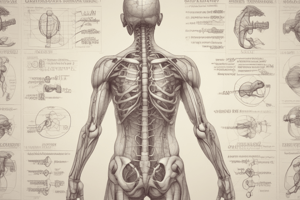Podcast
Questions and Answers
Physiology deals with the functions of organs and organ systems.
Physiology deals with the functions of organs and organ systems.
True (A)
Anatomy is the study of the functions of organs and organ systems.
Anatomy is the study of the functions of organs and organ systems.
False (B)
Regional anatomy focuses on the study of a specific part of the body, such as the head or the thorax.
Regional anatomy focuses on the study of a specific part of the body, such as the head or the thorax.
True (A)
Surface anatomy is a part of systemic anatomy.
Surface anatomy is a part of systemic anatomy.
Systemic anatomy focuses on the body's organ systems and their functions.
Systemic anatomy focuses on the body's organ systems and their functions.
The anatomical position is characterized by standing upright with feet together, toes pointing forward, and hands by the side with palms facing anteriorly.
The anatomical position is characterized by standing upright with feet together, toes pointing forward, and hands by the side with palms facing anteriorly.
The right lateral recumbent position involves lying on the left side.
The right lateral recumbent position involves lying on the left side.
Embryology is a part of histology.
Embryology is a part of histology.
The respiratory system exchanges oxygen and carbon dioxide between the air and blood.
The respiratory system exchanges oxygen and carbon dioxide between the air and blood.
The endocrine system regulates body functions such as movement by means of electrochemical impulses.
The endocrine system regulates body functions such as movement by means of electrochemical impulses.
The directional term 'proximal' refers to being closer to the midline.
The directional term 'proximal' refers to being closer to the midline.
The transverse plane divides the body into superior and inferior parts.
The transverse plane divides the body into superior and inferior parts.
The spleen is part of the cardiovascular system.
The spleen is part of the cardiovascular system.
The urinary system regulates volume and pH of blood and tissue fluid.
The urinary system regulates volume and pH of blood and tissue fluid.
The prone position involves lying on the back.
The prone position involves lying on the back.
The skin serves as a barrier to pathogens and chemicals.
The skin serves as a barrier to pathogens and chemicals.
Surface anatomy is a part of regional anatomy.
Surface anatomy is a part of regional anatomy.
Embryology is a part of systemic anatomy.
Embryology is a part of systemic anatomy.
The transverse plane divides the body into superior and inferior parts.
The transverse plane divides the body into superior and inferior parts.
The anatomical position is characterized by standing upright with feet together, toes pointing forward, and hands by the side with palms facing anteriorly.
The anatomical position is characterized by standing upright with feet together, toes pointing forward, and hands by the side with palms facing anteriorly.
The right lateral recumbent position involves lying on the left side.
The right lateral recumbent position involves lying on the left side.
The skin serves as a barrier to pathogens and chemicals.
The skin serves as a barrier to pathogens and chemicals.
The lithotomy position involves lying supine with the hips and knees flexed.
The lithotomy position involves lying supine with the hips and knees flexed.
The median sagittal plane divides the body into anterior and posterior parts.
The median sagittal plane divides the body into anterior and posterior parts.
The directional term 'peripheral' refers to being closer to the midline.
The directional term 'peripheral' refers to being closer to the midline.
The parietal layer is located within or interior to the main part.
The parietal layer is located within or interior to the main part.
The cardiovascular system transports oxygen and nutrients to tissues and removes waste products.
The cardiovascular system transports oxygen and nutrients to tissues and removes waste products.
The endocrine system produces eggs or sperm.
The endocrine system produces eggs or sperm.
The respiratory system prevents excessive water loss.
The respiratory system prevents excessive water loss.
The right lateral recumbent position involves lying on the right side.
The right lateral recumbent position involves lying on the right side.
The spleen is part of the urinary system.
The spleen is part of the urinary system.
The anatomical position involves standing upright with feet together, toes pointing forward, and hands by the side with palms facing posteriorly.
The anatomical position involves standing upright with feet together, toes pointing forward, and hands by the side with palms facing posteriorly.
Flashcards are hidden until you start studying





